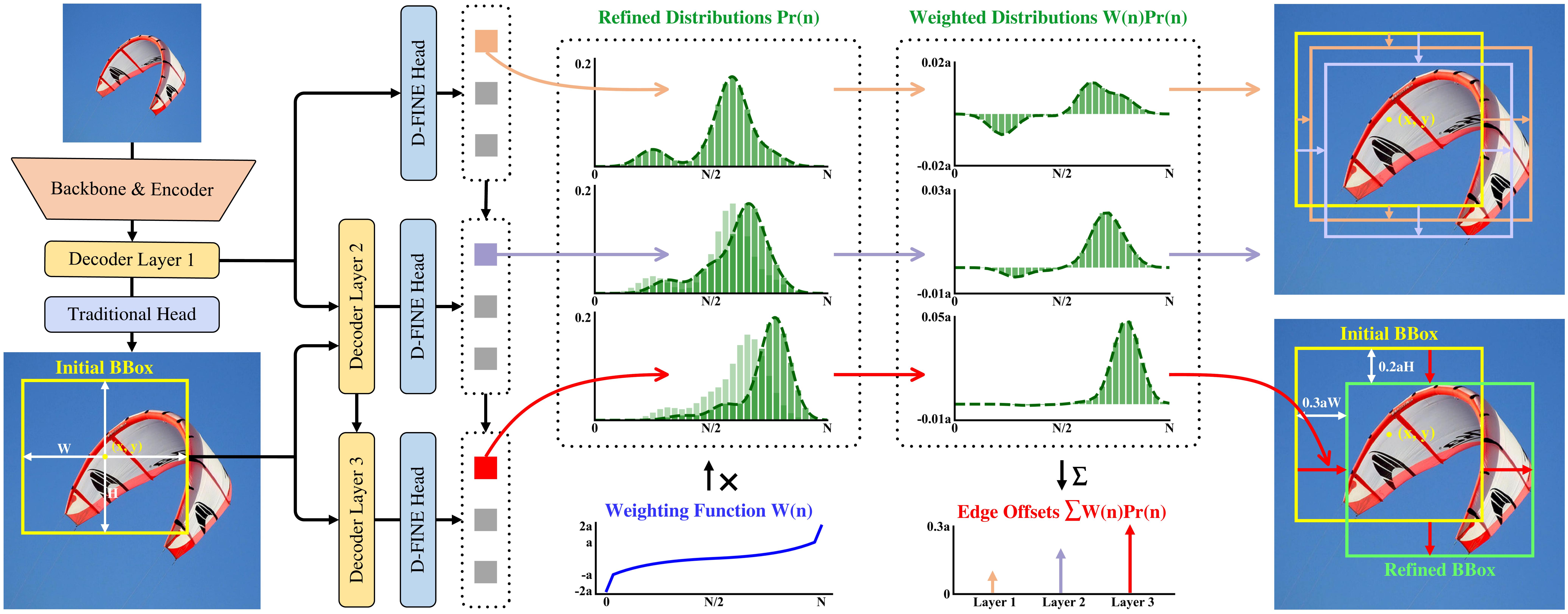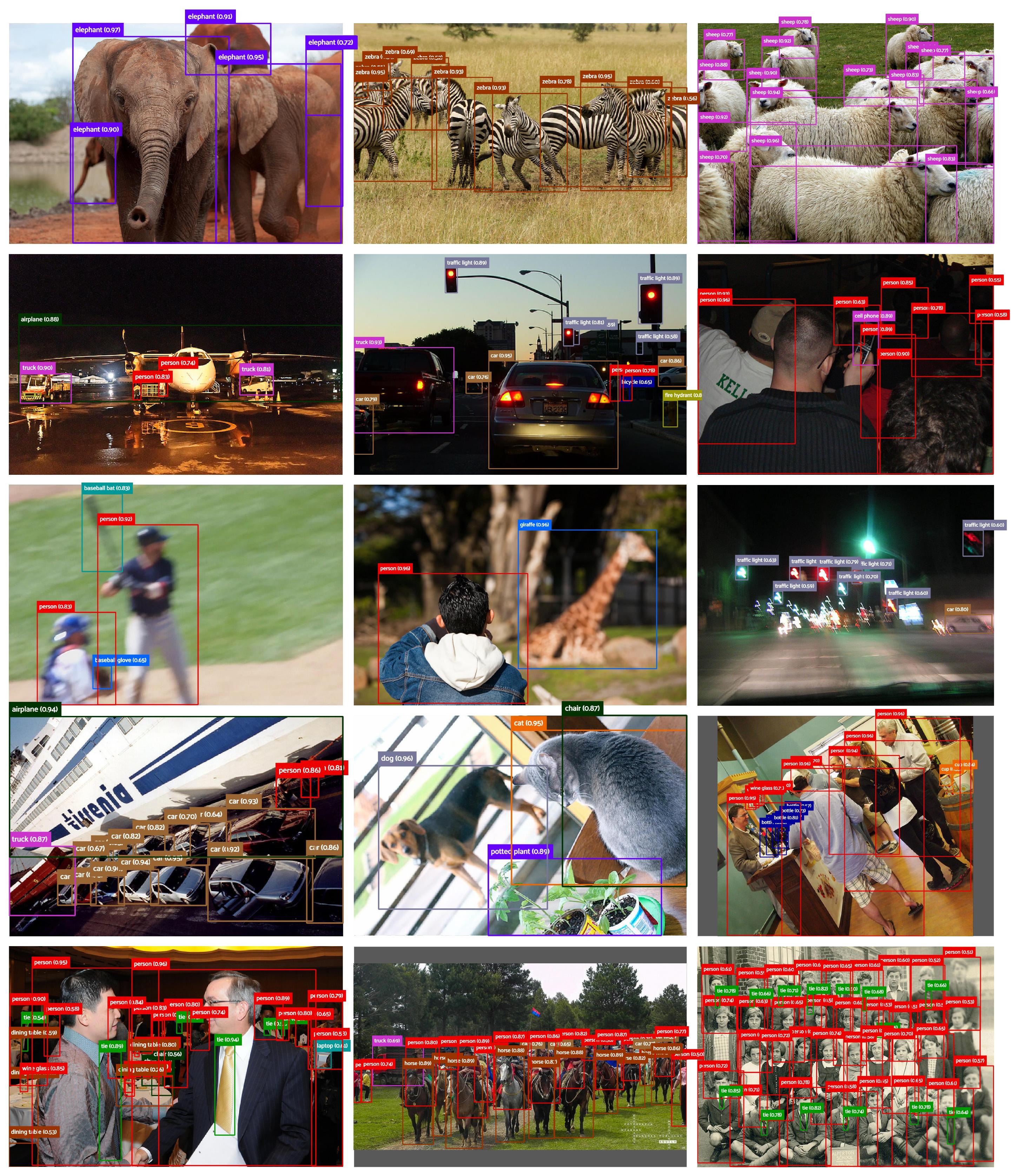English | 简体中文 | 日本語 | English Blog | 中文博客
📄 This is the official implementation of the paper:
D-FINE: Redefine Regression Task of DETRs as Fine-grained Distribution Refinement
Yansong Peng, Hebei Li, Peixi Wu, Yueyi Zhang, Xiaoyan Sun, and Feng Wu
University of Science and Technology of China
If you like D-FINE, please give us a ⭐! Your support motivates us to keep improving!
D-FINE is a powerful real-time object detector that redefines the bounding box regression task in DETRs as Fine-grained Distribution Refinement (FDR) and introduces Global Optimal Localization Self-Distillation (GO-LSD), achieving outstanding performance without introducing additional inference and training costs.
Video
We conduct object detection using D-FINE and YOLO11 on a complex street scene video from YouTube. Despite challenging conditions such as backlighting, motion blur, and dense crowds, D-FINE-X successfully detects nearly all targets, including subtle small objects like backpacks, bicycles, and traffic lights. Its confidence scores and the localization precision for blurred edges are significantly higher than those of YOLO11.
video_vis.mp4
- [2024.10.18] Release D-FINE series.
- [2024.10.25] Add custom dataset finetuning configs (#7).
- [2024.10.30] Update D-FINE-L (E25) pretrained model, with performance improved by 2.0%.
- [2024.11.07] Release D-FINE-N, achiving 42.8% APval on COCO @ 472 FPST4!
| Model | Dataset | APval | #Params | Latency | GFLOPs | config | checkpoint | logs |
|---|---|---|---|---|---|---|---|---|
| D‑FINE‑N | COCO | 42.8 | 4M | 2.12ms | 7 | yml | 42.8 | url |
| D‑FINE‑S | COCO | 48.5 | 10M | 3.49ms | 25 | yml | 48.5 | url |
| D‑FINE‑M | COCO | 52.3 | 19M | 5.62ms | 57 | yml | 52.3 | url |
| D‑FINE‑L | COCO | 54.0 | 31M | 8.07ms | 91 | yml | 54.0 | url |
| D‑FINE‑X | COCO | 55.8 | 62M | 12.89ms | 202 | yml | 55.8 | url |
| Model | Dataset | APval | #Params | Latency | GFLOPs | config | checkpoint | logs |
|---|---|---|---|---|---|---|---|---|
| D‑FINE‑S | Objects365+COCO | 50.7 | 10M | 3.49ms | 25 | yml | 50.7 | url |
| D‑FINE‑M | Objects365+COCO | 55.1 | 19M | 5.62ms | 57 | yml | 55.1 | url |
| D‑FINE‑L | Objects365+COCO | 57.3 | 31M | 8.07ms | 91 | yml | 57.3 | url |
| D‑FINE‑X | Objects365+COCO | 59.3 | 62M | 12.89ms | 202 | yml | 59.3 | url |
We highly recommend that you use the Objects365 pre-trained model for fine-tuning:
🔥 Pretrained Models on Objects365 (Best generalization)
| Model | Dataset | APval | AP5000 | #Params | Latency | GFLOPs | config | checkpoint | logs |
|---|---|---|---|---|---|---|---|---|---|
| D‑FINE‑S | Objects365 | 31.0 | 30.5 | 10M | 3.49ms | 25 | yml | 30.5 | url |
| D‑FINE‑M | Objects365 | 38.6 | 37.4 | 19M | 5.62ms | 57 | yml | 37.4 | url |
| D‑FINE‑L | Objects365 | - | 40.6 | 31M | 8.07ms | 91 | yml | 40.6 | url |
| D‑FINE‑L (E25) | Objects365 | 44.7 | 42.6 | 31M | 8.07ms | 91 | yml | 42.6 | url |
| D‑FINE‑X | Objects365 | 49.5 | 46.5 | 62M | 12.89ms | 202 | yml | 46.5 | url |
- E25: Re-trained and extended the pretraining to 25 epochs.
- APval is evaluated on Objects365 full validation set.
- AP5000 is evaluated on the first 5000 samples of the Objects365 validation set.
Notes:
- APval is evaluated on MSCOCO val2017 dataset.
-
Latency is evaluated on a single T4 GPU with
$batch\_size = 1$ ,$fp16$ , and$TensorRT==10.4.0$ . - Objects365+COCO means finetuned model on COCO using pretrained weights trained on Objects365.
conda create -n dfine python=3.11.9
conda activate dfine
pip install -r requirements.txtCOCO2017 Dataset
-
Download COCO2017 from OpenDataLab or COCO.
-
Modify paths in coco_detection.yml
train_dataloader: img_folder: /data/COCO2017/train2017/ ann_file: /data/COCO2017/annotations/instances_train2017.json val_dataloader: img_folder: /data/COCO2017/val2017/ ann_file: /data/COCO2017/annotations/instances_val2017.json
Objects365 Dataset
-
Download Objects365 from OpenDataLab.
-
Set the Base Directory:
export BASE_DIR=/data/Objects365/data- Extract and organize the downloaded files, resulting directory structure:
${BASE_DIR}/train
├── images
│ ├── v1
│ │ ├── patch0
│ │ │ ├── 000000000.jpg
│ │ │ ├── 000000001.jpg
│ │ │ └── ... (more images)
│ ├── v2
│ │ ├── patchx
│ │ │ ├── 000000000.jpg
│ │ │ ├── 000000001.jpg
│ │ │ └── ... (more images)
├── zhiyuan_objv2_train.json${BASE_DIR}/val
├── images
│ ├── v1
│ │ ├── patch0
│ │ │ ├── 000000000.jpg
│ │ │ └── ... (more images)
│ ├── v2
│ │ ├── patchx
│ │ │ ├── 000000000.jpg
│ │ │ └── ... (more images)
├── zhiyuan_objv2_val.json- Create a New Directory to Store Images from the Validation Set:
mkdir -p ${BASE_DIR}/train/images_from_val- Copy the v1 and v2 folders from the val directory into the train/images_from_val directory
cp -r ${BASE_DIR}/val/images/v1 ${BASE_DIR}/train/images_from_val/
cp -r ${BASE_DIR}/val/images/v2 ${BASE_DIR}/train/images_from_val/- Run remap_obj365.py to merge a subset of the validation set into the training set. Specifically, this script moves samples with indices between 5000 and 800000 from the validation set to the training set.
python tools/remap_obj365.py --base_dir ${BASE_DIR}- Run the resize_obj365.py script to resize any images in the dataset where the maximum edge length exceeds 640 pixels. Use the updated JSON file generated in Step 5 to process the sample data. Ensure that you resize images in both the train and val datasets to maintain consistency.
python tools/resize_obj365.py --base_dir ${BASE_DIR}-
Modify paths in obj365_detection.yml
train_dataloader: img_folder: /data/Objects365/data/train ann_file: /data/Objects365/data/train/new_zhiyuan_objv2_train_resized.json val_dataloader: img_folder: /data/Objects365/data/val/ ann_file: /data/Objects365/data/val/new_zhiyuan_objv2_val_resized.json
CrowdHuman
Download COCO format dataset here: url
Custom Dataset
To train on your custom dataset, you need to organize it in the COCO format. Follow the steps below to prepare your dataset:
-
Set
remap_mscoco_categorytoFalse:This prevents the automatic remapping of category IDs to match the MSCOCO categories.
remap_mscoco_category: False
-
Organize Images:
Structure your dataset directories as follows:
dataset/ ├── images/ │ ├── train/ │ │ ├── image1.jpg │ │ ├── image2.jpg │ │ └── ... │ ├── val/ │ │ ├── image1.jpg │ │ ├── image2.jpg │ │ └── ... └── annotations/ ├── instances_train.json ├── instances_val.json └── ...images/train/: Contains all training images.images/val/: Contains all validation images.annotations/: Contains COCO-formatted annotation files.
-
Convert Annotations to COCO Format:
If your annotations are not already in COCO format, you'll need to convert them. You can use the following Python script as a reference or utilize existing tools:
import json def convert_to_coco(input_annotations, output_annotations): # Implement conversion logic here pass if __name__ == "__main__": convert_to_coco('path/to/your_annotations.json', 'dataset/annotations/instances_train.json')
-
Update Configuration Files:
Modify your custom_detection.yml.
task: detection evaluator: type: CocoEvaluator iou_types: ['bbox', ] num_classes: 777 # your dataset classes remap_mscoco_category: False train_dataloader: type: DataLoader dataset: type: CocoDetection img_folder: /data/yourdataset/train ann_file: /data/yourdataset/train/train.json return_masks: False transforms: type: Compose ops: ~ shuffle: True num_workers: 4 drop_last: True collate_fn: type: BatchImageCollateFunction val_dataloader: type: DataLoader dataset: type: CocoDetection img_folder: /data/yourdataset/val ann_file: /data/yourdataset/val/ann.json return_masks: False transforms: type: Compose ops: ~ shuffle: False num_workers: 4 drop_last: False collate_fn: type: BatchImageCollateFunction
COCO2017
- Set Model
export model=l # n s m l x- Training
CUDA_VISIBLE_DEVICES=0,1,2,3 torchrun --master_port=7777 --nproc_per_node=4 train.py -c configs/dfine/dfine_hgnetv2_${model}_coco.yml --use-amp --seed=0- Testing
CUDA_VISIBLE_DEVICES=0,1,2,3 torchrun --master_port=7777 --nproc_per_node=4 train.py -c configs/dfine/dfine_hgnetv2_${model}_coco.yml --test-only -r model.pth- Tuning
CUDA_VISIBLE_DEVICES=0,1,2,3 torchrun --master_port=7777 --nproc_per_node=4 train.py -c configs/dfine/dfine_hgnetv2_${model}_coco.yml --use-amp --seed=0 -t model.pthObjects365 to COCO2017
- Set Model
export model=l # n s m l x- Training on Objects365
CUDA_VISIBLE_DEVICES=0,1,2,3 torchrun --master_port=7777 --nproc_per_node=4 train.py -c configs/dfine/objects365/dfine_hgnetv2_${model}_obj365.yml --use-amp --seed=0- Tuning on COCO2017
CUDA_VISIBLE_DEVICES=0,1,2,3 torchrun --master_port=7777 --nproc_per_node=4 train.py -c configs/dfine/objects365/dfine_hgnetv2_${model}_obj2coco.yml --use-amp --seed=0 -t model.pth- Testing
CUDA_VISIBLE_DEVICES=0,1,2,3 torchrun --master_port=7777 --nproc_per_node=4 train.py -c configs/dfine/dfine_hgnetv2_${model}_coco.yml --test-only -r model.pthCustom Dataset
- Set Model
export model=l # n s m l x- Training on Custom Dataset
CUDA_VISIBLE_DEVICES=0,1,2,3 torchrun --master_port=7777 --nproc_per_node=4 train.py -c configs/dfine/custom/dfine_hgnetv2_${model}_custom.yml --use-amp --seed=0- Testing
CUDA_VISIBLE_DEVICES=0,1,2,3 torchrun --master_port=7777 --nproc_per_node=4 train.py -c configs/dfine/custom/dfine_hgnetv2_${model}_custom.yml --test-only -r model.pth- Tuning on Custom Dataset
CUDA_VISIBLE_DEVICES=0,1,2,3 torchrun --master_port=7777 --nproc_per_node=4 train.py -c configs/dfine/custom/objects365/dfine_hgnetv2_${model}_obj2custom.yml --use-amp --seed=0 -t model.pth- [Optional] Modify Class Mappings:
When using the Objects365 pre-trained weights to train on your custom dataset, the example assumes that your dataset only contains the classes 'Person' and 'Car'. For faster convergence, you can modify self.obj365_ids in src/solver/_solver.py as follows:
self.obj365_ids = [0, 5] # Person, CarsYou can replace these with any corresponding classes from your dataset. The list of Objects365 classes with their corresponding IDs: https://github.com/Peterande/D-FINE/blob/352a94ece291e26e1957df81277bef00fe88a8e3/src/solver/_solver.py#L330
New training command:
CUDA_VISIBLE_DEVICES=0,1,2,3 torchrun --master_port=7777 --nproc_per_node=4 train.py -c configs/dfine/custom/dfine_hgnetv2_${model}_custom.yml --use-amp --seed=0 -t model.pthHowever, if you don't wish to modify the class mappings, the pre-trained Objects365 weights will still work without any changes. Modifying the class mappings is optional and can potentially accelerate convergence for specific tasks.
Customizing Batch Size
For example, if you want to double the total batch size when training D-FINE-L on COCO2017, here are the steps you should follow:
-
Modify your dataloader.yml to increase the
total_batch_size:train_dataloader: total_batch_size: 64 # Previously it was 32, now doubled
-
Modify your dfine_hgnetv2_l_coco.yml. Here’s how the key parameters should be adjusted:
optimizer: type: AdamW params: - params: '^(?=.*backbone)(?!.*norm|bn).*$' lr: 0.000025 # doubled, linear scaling law - params: '^(?=.*(?:encoder|decoder))(?=.*(?:norm|bn)).*$' weight_decay: 0. lr: 0.0005 # doubled, linear scaling law betas: [0.9, 0.999] weight_decay: 0.0001 # need a grid search ema: # added EMA settings decay: 0.9998 # adjusted by 1 - (1 - decay) * 2 warmups: 500 # halved lr_warmup_scheduler: warmup_duration: 250 # halved
Customizing Input Size
If you'd like to train D-FINE-L on COCO2017 with an input size of 320x320, follow these steps:
-
Modify your dataloader.yml:
train_dataloader: dataset: transforms: ops: - {type: Resize, size: [320, 320], } collate_fn: base_size: 320 dataset: transforms: ops: - {type: Resize, size: [320, 320], }
-
Modify your dfine_hgnetv2.yml:
eval_spatial_size: [320, 320]
Deployment
- Setup
pip install onnx onnxsim
export model=l # n s m l x- Export onnx
python tools/deployment/export_onnx.py --check -c configs/dfine/dfine_hgnetv2_${model}_coco.yml -r model.pth- Export tensorrt
trtexec --onnx="model.onnx" --saveEngine="model.engine" --fp16Inference (Visualization)
- Setup
pip install -r tools/inference/requirements.txt
export model=l # n s m l x- Inference (onnxruntime / tensorrt / torch)
Inference on images and videos is now supported.
python tools/inference/onnx_inf.py --onnx model.onnx --input image.jpg # video.mp4
python tools/inference/trt_inf.py --trt model.engine --input image.jpg
python tools/inference/torch_inf.py -c configs/dfine/dfine_hgnetv2_${model}_coco.yml -r model.pth --input image.jpg --device cuda:0Benchmark
- Setup
pip install -r tools/benchmark/requirements.txt
export model=l # n s m l x- Model FLOPs, MACs, and Params
python tools/benchmark/get_info.py -c configs/dfine/dfine_hgnetv2_${model}_coco.yml- TensorRT Latency
python tools/benchmark/trt_benchmark.py --COCO_dir path/to/COCO2017 --engine_dir model.engineFiftyone Visualization
- Setup
pip install fiftyone
export model=l # n s m l x- Voxel51 Fiftyone Visualization (fiftyone)
python tools/visualization/fiftyone_vis.py -c configs/dfine/dfine_hgnetv2_${model}_coco.yml -r model.pthOthers
- Auto Resume Training
bash reference/safe_training.sh- Converting Model Weights
python reference/convert_weight.py model.pthFDR and GO-LSD
- Overview of D-FINE with FDR. The probability distributions that act as a more fine- grained intermediate representation are iteratively refined by the decoder layers in a residual manner. Non-uniform weighting functions are applied to allow for finer localization.
- Overview of GO-LSD process. Localization knowledge from the final layer’s refined distributions is distilled into earlier layers through DDF loss with decoupled weighting strategies.
Distributions
Visualizations of FDR across detection scenarios with initial and refined bounding boxes, along with unweighted and weighted distributions.
Hard Cases
The following visualization demonstrates D-FINE's predictions in various complex detection scenarios. These include cases with occlusion, low-light conditions, motion blur, depth of field effects, and densely populated scenes. Despite these challenges, D-FINE consistently produces accurate localization results.
If you use D-FINE or its methods in your work, please cite the following BibTeX entries:
bibtex
@misc{peng2024dfine,
title={D-FINE: Redefine Regression Task in DETRs as Fine-grained Distribution Refinement},
author={Yansong Peng and Hebei Li and Peixi Wu and Yueyi Zhang and Xiaoyan Sun and Feng Wu},
year={2024},
eprint={2410.13842},
archivePrefix={arXiv},
primaryClass={cs.CV}
}Our work is built upon RT-DETR. Thanks to the inspirations from RT-DETR, GFocal, LD, and YOLOv9.
✨ Feel free to contribute and reach out if you have any questions! ✨










